Role of Financial Management in Decision Making - Tesco plc
VerifiedAdded on 2023/01/07
|20
|5048
|59
AI Summary
This report discusses the role of financial management in decision making and strategies for fraud reduction in Tesco plc. It covers topics such as management accounting techniques, stakeholder management, cost control, fraud detection, and ethical decision making. The report provides insights into the importance of financial data in taking operational and strategic decisions and offers practical implications for Tesco plc.
Contribute Materials
Your contribution can guide someone’s learning journey. Share your
documents today.
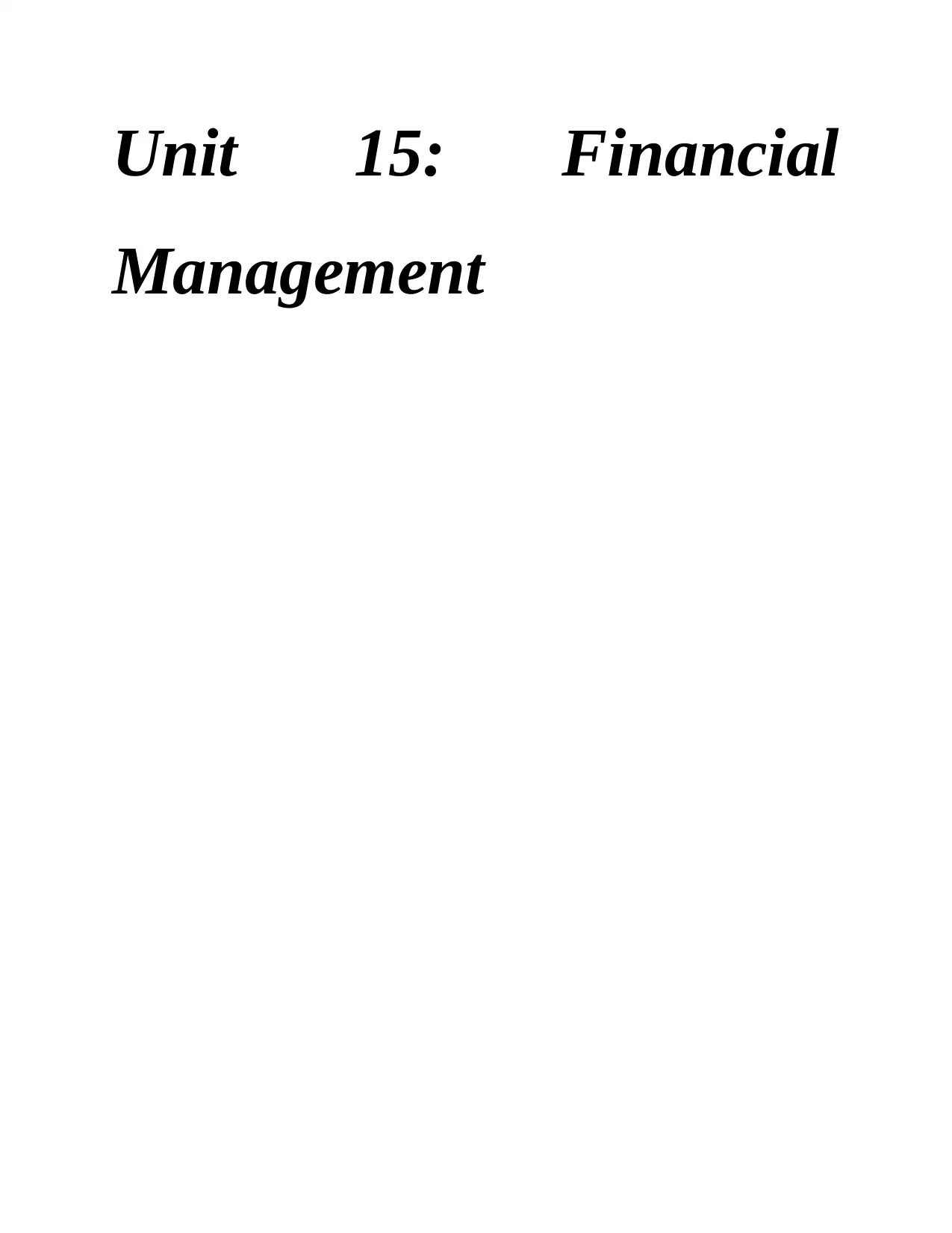
Unit 15: Financial
Management
Management
Secure Best Marks with AI Grader
Need help grading? Try our AI Grader for instant feedback on your assignments.

Contents
INTRODUCTION.......................................................................................................................................3
MAIN BODY..............................................................................................................................................3
Scenario A:..............................................................................................................................................3
Scenario B:..............................................................................................................................................9
CONCLUSION.........................................................................................................................................17
REFERENCES..........................................................................................................................................19
INTRODUCTION.......................................................................................................................................3
MAIN BODY..............................................................................................................................................3
Scenario A:..............................................................................................................................................3
Scenario B:..............................................................................................................................................9
CONCLUSION.........................................................................................................................................17
REFERENCES..........................................................................................................................................19
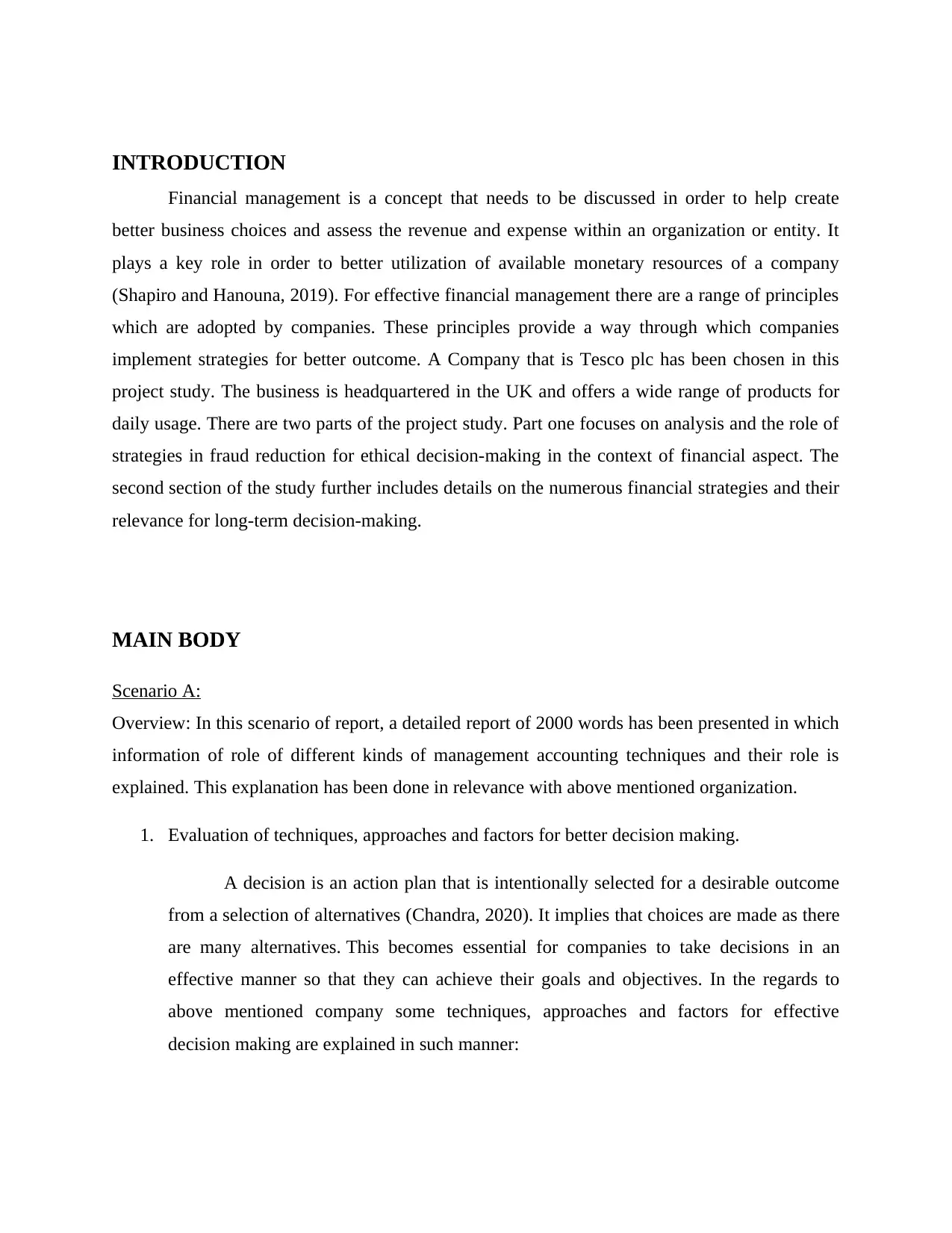
INTRODUCTION
Financial management is a concept that needs to be discussed in order to help create
better business choices and assess the revenue and expense within an organization or entity. It
plays a key role in order to better utilization of available monetary resources of a company
(Shapiro and Hanouna, 2019). For effective financial management there are a range of principles
which are adopted by companies. These principles provide a way through which companies
implement strategies for better outcome. A Company that is Tesco plc has been chosen in this
project study. The business is headquartered in the UK and offers a wide range of products for
daily usage. There are two parts of the project study. Part one focuses on analysis and the role of
strategies in fraud reduction for ethical decision-making in the context of financial aspect. The
second section of the study further includes details on the numerous financial strategies and their
relevance for long-term decision-making.
MAIN BODY
Scenario A:
Overview: In this scenario of report, a detailed report of 2000 words has been presented in which
information of role of different kinds of management accounting techniques and their role is
explained. This explanation has been done in relevance with above mentioned organization.
1. Evaluation of techniques, approaches and factors for better decision making.
A decision is an action plan that is intentionally selected for a desirable outcome
from a selection of alternatives (Chandra, 2020). It implies that choices are made as there
are many alternatives. This becomes essential for companies to take decisions in an
effective manner so that they can achieve their goals and objectives. In the regards to
above mentioned company some techniques, approaches and factors for effective
decision making are explained in such manner:
Financial management is a concept that needs to be discussed in order to help create
better business choices and assess the revenue and expense within an organization or entity. It
plays a key role in order to better utilization of available monetary resources of a company
(Shapiro and Hanouna, 2019). For effective financial management there are a range of principles
which are adopted by companies. These principles provide a way through which companies
implement strategies for better outcome. A Company that is Tesco plc has been chosen in this
project study. The business is headquartered in the UK and offers a wide range of products for
daily usage. There are two parts of the project study. Part one focuses on analysis and the role of
strategies in fraud reduction for ethical decision-making in the context of financial aspect. The
second section of the study further includes details on the numerous financial strategies and their
relevance for long-term decision-making.
MAIN BODY
Scenario A:
Overview: In this scenario of report, a detailed report of 2000 words has been presented in which
information of role of different kinds of management accounting techniques and their role is
explained. This explanation has been done in relevance with above mentioned organization.
1. Evaluation of techniques, approaches and factors for better decision making.
A decision is an action plan that is intentionally selected for a desirable outcome
from a selection of alternatives (Chandra, 2020). It implies that choices are made as there
are many alternatives. This becomes essential for companies to take decisions in an
effective manner so that they can achieve their goals and objectives. In the regards to
above mentioned company some techniques, approaches and factors for effective
decision making are explained in such manner:
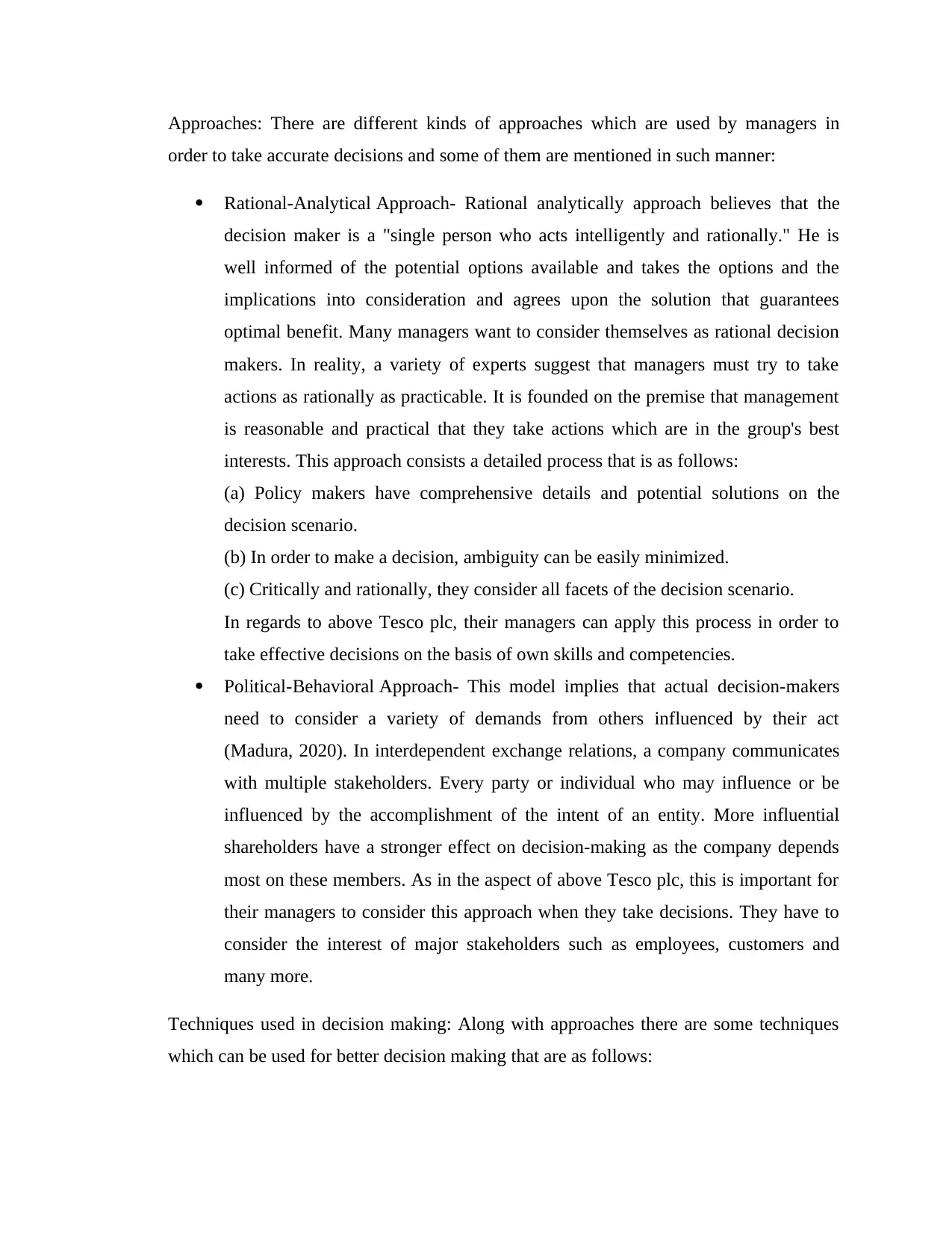
Approaches: There are different kinds of approaches which are used by managers in
order to take accurate decisions and some of them are mentioned in such manner:
Rational-Analytical Approach- Rational analytically approach believes that the
decision maker is a "single person who acts intelligently and rationally." He is
well informed of the potential options available and takes the options and the
implications into consideration and agrees upon the solution that guarantees
optimal benefit. Many managers want to consider themselves as rational decision
makers. In reality, a variety of experts suggest that managers must try to take
actions as rationally as practicable. It is founded on the premise that management
is reasonable and practical that they take actions which are in the group's best
interests. This approach consists a detailed process that is as follows:
(a) Policy makers have comprehensive details and potential solutions on the
decision scenario.
(b) In order to make a decision, ambiguity can be easily minimized.
(c) Critically and rationally, they consider all facets of the decision scenario.
In regards to above Tesco plc, their managers can apply this process in order to
take effective decisions on the basis of own skills and competencies.
Political-Behavioral Approach- This model implies that actual decision-makers
need to consider a variety of demands from others influenced by their act
(Madura, 2020). In interdependent exchange relations, a company communicates
with multiple stakeholders. Every party or individual who may influence or be
influenced by the accomplishment of the intent of an entity. More influential
shareholders have a stronger effect on decision-making as the company depends
most on these members. As in the aspect of above Tesco plc, this is important for
their managers to consider this approach when they take decisions. They have to
consider the interest of major stakeholders such as employees, customers and
many more.
Techniques used in decision making: Along with approaches there are some techniques
which can be used for better decision making that are as follows:
order to take accurate decisions and some of them are mentioned in such manner:
Rational-Analytical Approach- Rational analytically approach believes that the
decision maker is a "single person who acts intelligently and rationally." He is
well informed of the potential options available and takes the options and the
implications into consideration and agrees upon the solution that guarantees
optimal benefit. Many managers want to consider themselves as rational decision
makers. In reality, a variety of experts suggest that managers must try to take
actions as rationally as practicable. It is founded on the premise that management
is reasonable and practical that they take actions which are in the group's best
interests. This approach consists a detailed process that is as follows:
(a) Policy makers have comprehensive details and potential solutions on the
decision scenario.
(b) In order to make a decision, ambiguity can be easily minimized.
(c) Critically and rationally, they consider all facets of the decision scenario.
In regards to above Tesco plc, their managers can apply this process in order to
take effective decisions on the basis of own skills and competencies.
Political-Behavioral Approach- This model implies that actual decision-makers
need to consider a variety of demands from others influenced by their act
(Madura, 2020). In interdependent exchange relations, a company communicates
with multiple stakeholders. Every party or individual who may influence or be
influenced by the accomplishment of the intent of an entity. More influential
shareholders have a stronger effect on decision-making as the company depends
most on these members. As in the aspect of above Tesco plc, this is important for
their managers to consider this approach when they take decisions. They have to
consider the interest of major stakeholders such as employees, customers and
many more.
Techniques used in decision making: Along with approaches there are some techniques
which can be used for better decision making that are as follows:
Paraphrase This Document
Need a fresh take? Get an instant paraphrase of this document with our AI Paraphraser

Financial analysis technique- This analysis method helps the feasibility of an
expenditure to be measured, the payback duration (the time span required to
compensate for financial gains with the actual expense of the project) to be
determined and cash inflows and capital outflows to be evaluated. Cash inflows
and capital outflows should be measured to determine investment choices. Under
it some other techniques are also used which can be useful for better decision
making in the context of above company.
Break even analysis- This method helps a decision maker to compare the options
available on the basis of size, fixed and variable unit costs. Analysis of break-
even is a calculation to assess the amount of revenue needed to pay all fixed costs.
The decision-maker can use this method to evaluate the break-even point for the
whole organization and all of its goods. Gross income is proportional to the
overall expense at the lowest stage and benefit is zero.
Factors affecting decision making: There are a range of factors which can affect decision
making in an organization and some of them are mentioned below:
Political factor- It is one of the main factor that impact the decision making. This
is so because if political conditions in a nation are not stable then it may lead to
change the entire policies of a company (Mitchell and Calabrese, 2019). Such as
in the case of above company if political conditions in UK are not favorable then
they has to take decisions accordingly. They cannot make larger investment at the
time of unstable political condition.
Economic factor- This factor include interest rate, exchange rate, inflation rate
and many more. It becomes essential for companies to take decisions by
considering these aspects. It is so because in the case when interest rate is higher
than companies cannot take decision for taking financial assistance from banks.
So these are some major factors, apart from these there are some other factors too as
social factor, technological and many more which need to be consider. Though above
mentioned factors are too crucial as compared to others.
expenditure to be measured, the payback duration (the time span required to
compensate for financial gains with the actual expense of the project) to be
determined and cash inflows and capital outflows to be evaluated. Cash inflows
and capital outflows should be measured to determine investment choices. Under
it some other techniques are also used which can be useful for better decision
making in the context of above company.
Break even analysis- This method helps a decision maker to compare the options
available on the basis of size, fixed and variable unit costs. Analysis of break-
even is a calculation to assess the amount of revenue needed to pay all fixed costs.
The decision-maker can use this method to evaluate the break-even point for the
whole organization and all of its goods. Gross income is proportional to the
overall expense at the lowest stage and benefit is zero.
Factors affecting decision making: There are a range of factors which can affect decision
making in an organization and some of them are mentioned below:
Political factor- It is one of the main factor that impact the decision making. This
is so because if political conditions in a nation are not stable then it may lead to
change the entire policies of a company (Mitchell and Calabrese, 2019). Such as
in the case of above company if political conditions in UK are not favorable then
they has to take decisions accordingly. They cannot make larger investment at the
time of unstable political condition.
Economic factor- This factor include interest rate, exchange rate, inflation rate
and many more. It becomes essential for companies to take decisions by
considering these aspects. It is so because in the case when interest rate is higher
than companies cannot take decision for taking financial assistance from banks.
So these are some major factors, apart from these there are some other factors too as
social factor, technological and many more which need to be consider. Though above
mentioned factors are too crucial as compared to others.
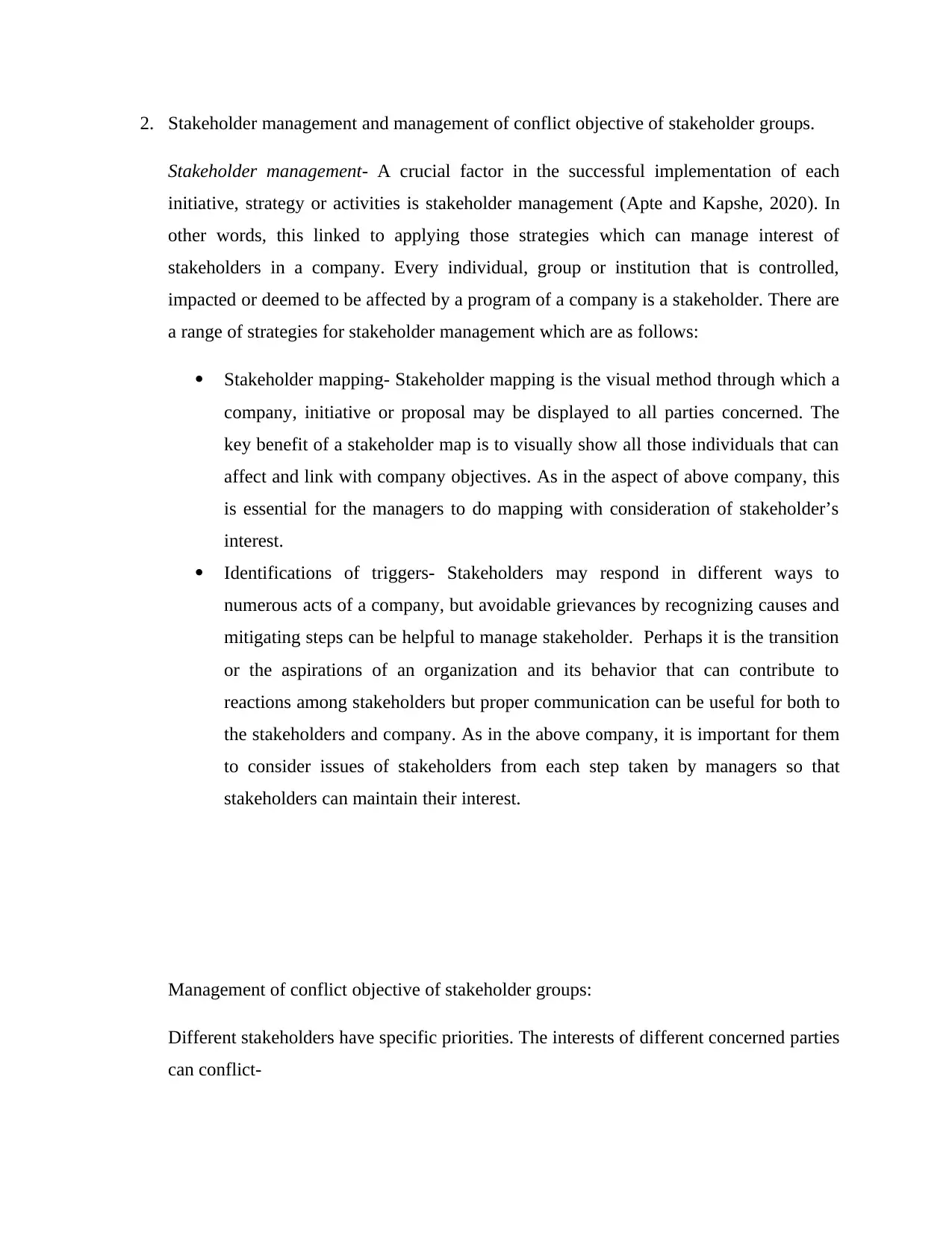
2. Stakeholder management and management of conflict objective of stakeholder groups.
Stakeholder management- A crucial factor in the successful implementation of each
initiative, strategy or activities is stakeholder management (Apte and Kapshe, 2020). In
other words, this linked to applying those strategies which can manage interest of
stakeholders in a company. Every individual, group or institution that is controlled,
impacted or deemed to be affected by a program of a company is a stakeholder. There are
a range of strategies for stakeholder management which are as follows:
Stakeholder mapping- Stakeholder mapping is the visual method through which a
company, initiative or proposal may be displayed to all parties concerned. The
key benefit of a stakeholder map is to visually show all those individuals that can
affect and link with company objectives. As in the aspect of above company, this
is essential for the managers to do mapping with consideration of stakeholder’s
interest.
Identifications of triggers- Stakeholders may respond in different ways to
numerous acts of a company, but avoidable grievances by recognizing causes and
mitigating steps can be helpful to manage stakeholder. Perhaps it is the transition
or the aspirations of an organization and its behavior that can contribute to
reactions among stakeholders but proper communication can be useful for both to
the stakeholders and company. As in the above company, it is important for them
to consider issues of stakeholders from each step taken by managers so that
stakeholders can maintain their interest.
Management of conflict objective of stakeholder groups:
Different stakeholders have specific priorities. The interests of different concerned parties
can conflict-
Stakeholder management- A crucial factor in the successful implementation of each
initiative, strategy or activities is stakeholder management (Apte and Kapshe, 2020). In
other words, this linked to applying those strategies which can manage interest of
stakeholders in a company. Every individual, group or institution that is controlled,
impacted or deemed to be affected by a program of a company is a stakeholder. There are
a range of strategies for stakeholder management which are as follows:
Stakeholder mapping- Stakeholder mapping is the visual method through which a
company, initiative or proposal may be displayed to all parties concerned. The
key benefit of a stakeholder map is to visually show all those individuals that can
affect and link with company objectives. As in the aspect of above company, this
is essential for the managers to do mapping with consideration of stakeholder’s
interest.
Identifications of triggers- Stakeholders may respond in different ways to
numerous acts of a company, but avoidable grievances by recognizing causes and
mitigating steps can be helpful to manage stakeholder. Perhaps it is the transition
or the aspirations of an organization and its behavior that can contribute to
reactions among stakeholders but proper communication can be useful for both to
the stakeholders and company. As in the above company, it is important for them
to consider issues of stakeholders from each step taken by managers so that
stakeholders can maintain their interest.
Management of conflict objective of stakeholder groups:
Different stakeholders have specific priorities. The interests of different concerned parties
can conflict-
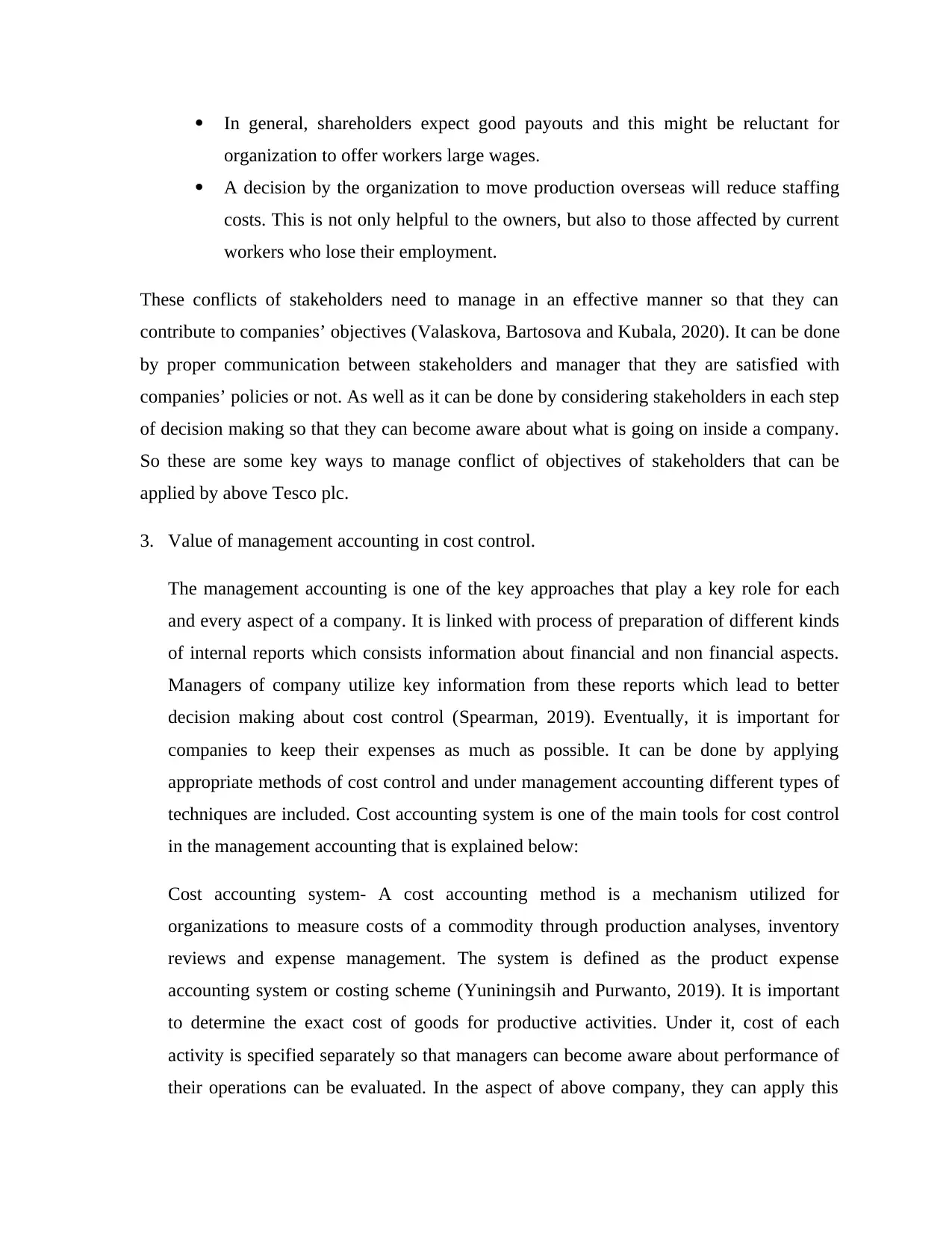
In general, shareholders expect good payouts and this might be reluctant for
organization to offer workers large wages.
A decision by the organization to move production overseas will reduce staffing
costs. This is not only helpful to the owners, but also to those affected by current
workers who lose their employment.
These conflicts of stakeholders need to manage in an effective manner so that they can
contribute to companies’ objectives (Valaskova, Bartosova and Kubala, 2020). It can be done
by proper communication between stakeholders and manager that they are satisfied with
companies’ policies or not. As well as it can be done by considering stakeholders in each step
of decision making so that they can become aware about what is going on inside a company.
So these are some key ways to manage conflict of objectives of stakeholders that can be
applied by above Tesco plc.
3. Value of management accounting in cost control.
The management accounting is one of the key approaches that play a key role for each
and every aspect of a company. It is linked with process of preparation of different kinds
of internal reports which consists information about financial and non financial aspects.
Managers of company utilize key information from these reports which lead to better
decision making about cost control (Spearman, 2019). Eventually, it is important for
companies to keep their expenses as much as possible. It can be done by applying
appropriate methods of cost control and under management accounting different types of
techniques are included. Cost accounting system is one of the main tools for cost control
in the management accounting that is explained below:
Cost accounting system- A cost accounting method is a mechanism utilized for
organizations to measure costs of a commodity through production analyses, inventory
reviews and expense management. The system is defined as the product expense
accounting system or costing scheme (Yuniningsih and Purwanto, 2019). It is important
to determine the exact cost of goods for productive activities. Under it, cost of each
activity is specified separately so that managers can become aware about performance of
their operations can be evaluated. In the aspect of above company, they can apply this
organization to offer workers large wages.
A decision by the organization to move production overseas will reduce staffing
costs. This is not only helpful to the owners, but also to those affected by current
workers who lose their employment.
These conflicts of stakeholders need to manage in an effective manner so that they can
contribute to companies’ objectives (Valaskova, Bartosova and Kubala, 2020). It can be done
by proper communication between stakeholders and manager that they are satisfied with
companies’ policies or not. As well as it can be done by considering stakeholders in each step
of decision making so that they can become aware about what is going on inside a company.
So these are some key ways to manage conflict of objectives of stakeholders that can be
applied by above Tesco plc.
3. Value of management accounting in cost control.
The management accounting is one of the key approaches that play a key role for each
and every aspect of a company. It is linked with process of preparation of different kinds
of internal reports which consists information about financial and non financial aspects.
Managers of company utilize key information from these reports which lead to better
decision making about cost control (Spearman, 2019). Eventually, it is important for
companies to keep their expenses as much as possible. It can be done by applying
appropriate methods of cost control and under management accounting different types of
techniques are included. Cost accounting system is one of the main tools for cost control
in the management accounting that is explained below:
Cost accounting system- A cost accounting method is a mechanism utilized for
organizations to measure costs of a commodity through production analyses, inventory
reviews and expense management. The system is defined as the product expense
accounting system or costing scheme (Yuniningsih and Purwanto, 2019). It is important
to determine the exact cost of goods for productive activities. Under it, cost of each
activity is specified separately so that managers can become aware about performance of
their operations can be evaluated. In the aspect of above company, they can apply this
Secure Best Marks with AI Grader
Need help grading? Try our AI Grader for instant feedback on your assignments.

model in order to manage their overall cost by help of above mentioned accounting
system.
4. Techniques for fraud detection and prevention.
Fraud must be detected as it may adversely affect the entire business. Companies are
faced with one million issues due to this. It is important that policies of fraud prevention
must be implemented to discourage risk in order to stop theft at an early level. One of the
strategies in order to prevent fraud is auditing that is explained in such manner:
Auditing- The word audit usually refers to an analysis of the records. An accurate audit
and review of the organization's financial statements is to insure the financial reports
reflect the activities they appear to be representing in a reasonable and correct manner
(Dermit-Richard, Scelles and Morrow, 2019). The examination may be conducted
remotely by company staff or independently by an authorized Certified Public
Accountant Corporation (CPA). The main objective behind applying this technique is to
find out those areas in which companies’ performance is unusual due to manipulation of
data. It the aspect of above company, this technique can be used in order to overcome
from fraud in their financial statements.
Approach to ethical decision making: There are a range of approaches which can be
applied in order to take decisions in an ethical manner. Below explanation of some
approaches is done in such manner:
Rights approach: It is focused on behavior founded on free will and derives from
Immanuel Kant et al’s Theory. This method encourages the freedom of people to
openly choose what to do with their lives and to have an inherent moral right to
do so. Everything that is legal consideration for the fundamental right. In the
context of above company, this can be applied from managers by providing
freedom to employees about expressing their views and opinions about a
particular aspect.
Justice approach- This approach is based on a concept that all individuals should
be treated in a common way during process of decision making. It can be done by
system.
4. Techniques for fraud detection and prevention.
Fraud must be detected as it may adversely affect the entire business. Companies are
faced with one million issues due to this. It is important that policies of fraud prevention
must be implemented to discourage risk in order to stop theft at an early level. One of the
strategies in order to prevent fraud is auditing that is explained in such manner:
Auditing- The word audit usually refers to an analysis of the records. An accurate audit
and review of the organization's financial statements is to insure the financial reports
reflect the activities they appear to be representing in a reasonable and correct manner
(Dermit-Richard, Scelles and Morrow, 2019). The examination may be conducted
remotely by company staff or independently by an authorized Certified Public
Accountant Corporation (CPA). The main objective behind applying this technique is to
find out those areas in which companies’ performance is unusual due to manipulation of
data. It the aspect of above company, this technique can be used in order to overcome
from fraud in their financial statements.
Approach to ethical decision making: There are a range of approaches which can be
applied in order to take decisions in an ethical manner. Below explanation of some
approaches is done in such manner:
Rights approach: It is focused on behavior founded on free will and derives from
Immanuel Kant et al’s Theory. This method encourages the freedom of people to
openly choose what to do with their lives and to have an inherent moral right to
do so. Everything that is legal consideration for the fundamental right. In the
context of above company, this can be applied from managers by providing
freedom to employees about expressing their views and opinions about a
particular aspect.
Justice approach- This approach is based on a concept that all individuals should
be treated in a common way during process of decision making. It can be done by
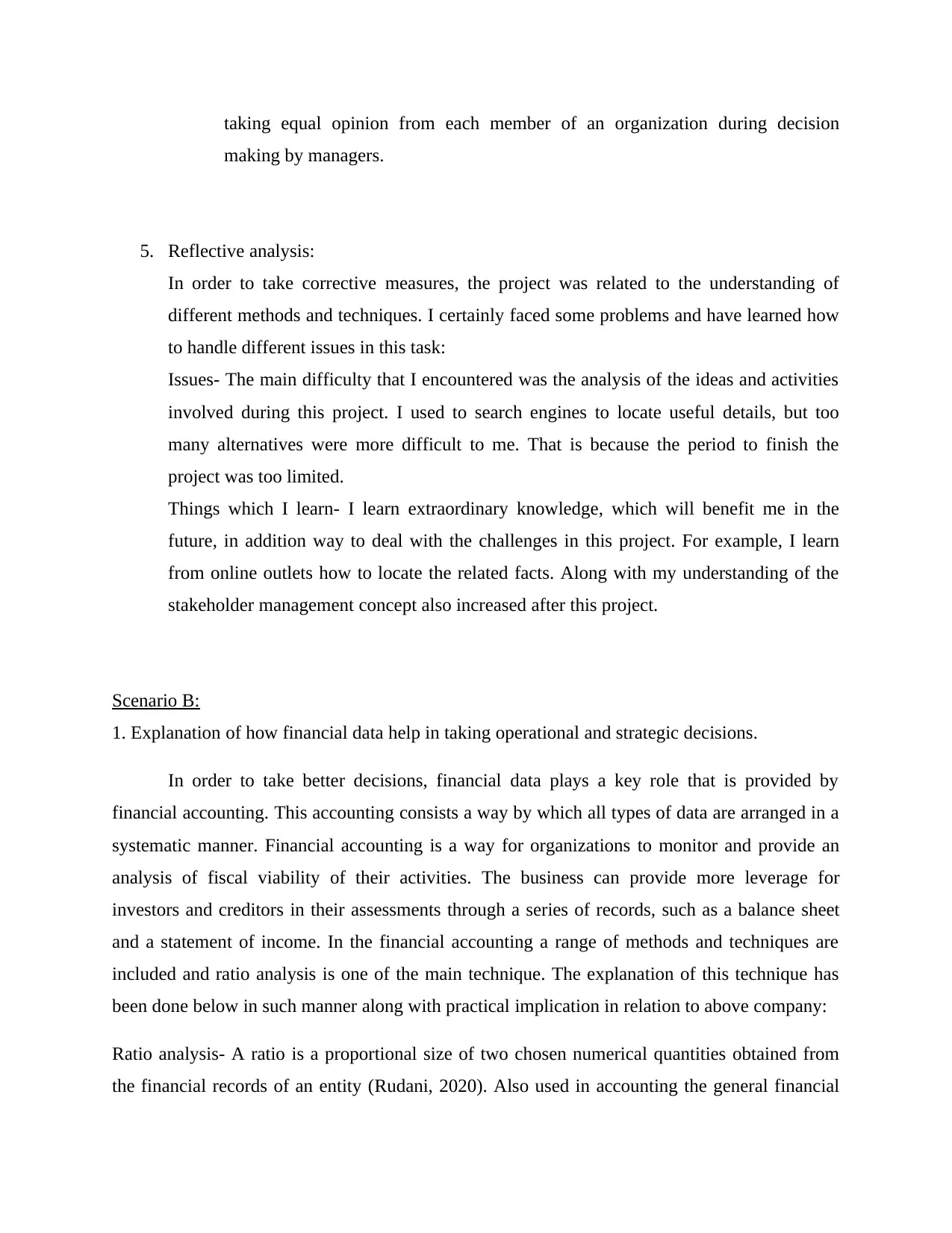
taking equal opinion from each member of an organization during decision
making by managers.
5. Reflective analysis:
In order to take corrective measures, the project was related to the understanding of
different methods and techniques. I certainly faced some problems and have learned how
to handle different issues in this task:
Issues- The main difficulty that I encountered was the analysis of the ideas and activities
involved during this project. I used to search engines to locate useful details, but too
many alternatives were more difficult to me. That is because the period to finish the
project was too limited.
Things which I learn- I learn extraordinary knowledge, which will benefit me in the
future, in addition way to deal with the challenges in this project. For example, I learn
from online outlets how to locate the related facts. Along with my understanding of the
stakeholder management concept also increased after this project.
Scenario B:
1. Explanation of how financial data help in taking operational and strategic decisions.
In order to take better decisions, financial data plays a key role that is provided by
financial accounting. This accounting consists a way by which all types of data are arranged in a
systematic manner. Financial accounting is a way for organizations to monitor and provide an
analysis of fiscal viability of their activities. The business can provide more leverage for
investors and creditors in their assessments through a series of records, such as a balance sheet
and a statement of income. In the financial accounting a range of methods and techniques are
included and ratio analysis is one of the main technique. The explanation of this technique has
been done below in such manner along with practical implication in relation to above company:
Ratio analysis- A ratio is a proportional size of two chosen numerical quantities obtained from
the financial records of an entity (Rudani, 2020). Also used in accounting the general financial
making by managers.
5. Reflective analysis:
In order to take corrective measures, the project was related to the understanding of
different methods and techniques. I certainly faced some problems and have learned how
to handle different issues in this task:
Issues- The main difficulty that I encountered was the analysis of the ideas and activities
involved during this project. I used to search engines to locate useful details, but too
many alternatives were more difficult to me. That is because the period to finish the
project was too limited.
Things which I learn- I learn extraordinary knowledge, which will benefit me in the
future, in addition way to deal with the challenges in this project. For example, I learn
from online outlets how to locate the related facts. Along with my understanding of the
stakeholder management concept also increased after this project.
Scenario B:
1. Explanation of how financial data help in taking operational and strategic decisions.
In order to take better decisions, financial data plays a key role that is provided by
financial accounting. This accounting consists a way by which all types of data are arranged in a
systematic manner. Financial accounting is a way for organizations to monitor and provide an
analysis of fiscal viability of their activities. The business can provide more leverage for
investors and creditors in their assessments through a series of records, such as a balance sheet
and a statement of income. In the financial accounting a range of methods and techniques are
included and ratio analysis is one of the main technique. The explanation of this technique has
been done below in such manner along with practical implication in relation to above company:
Ratio analysis- A ratio is a proportional size of two chosen numerical quantities obtained from
the financial records of an entity (Rudani, 2020). Also used in accounting the general financial

position of a company or other entity is determined by a set of regular ratios. Ratio evaluations
are a predictive approach of analyzing their accounting documents such as the balance sheet and
the income statement, and gives visibility into liquidity, operating performance and productivity.
The ratio analysis is a basic element of the equity analysis. In the context of above Tesco plc,
different types of ratios are calculated in order to understand role of data for decision making:
Profitability ratio: Profitability ratios are a category of financial measure which is used to
evaluate the ability of a company to produce profits in support of its revenues, operational
expenses, balance sheet assets or debt, utilizing data from a particular point of time. It includes
some ratios:
Gross profit ratio: Gross profit/net sales*100
All data in £ Million except Gross
profit margin
2017 2018
Sales 55,917 57,491
Gross profit 2, 902 3,350
Calculation 2902/55917*100 3350/57491*100
Gross profit margin 5.19% 5.83%
Net profit ratio: Net profit/net sales
All data in £ Million except Net profit
margin
2017 2018
Sales 55,917 57,491
Net profit -40 1206
Calculation -40/55917*100 1206/57491*100
Net profit margin -0.07% 2.09%
The above mentioned data of profitability ratio can be used in order to take crucial
decision about investment and other aspects. Such as above value of gross and net
margin, this can be find out that company’s performance was better in year 2018 as
compared to year 2017.
are a predictive approach of analyzing their accounting documents such as the balance sheet and
the income statement, and gives visibility into liquidity, operating performance and productivity.
The ratio analysis is a basic element of the equity analysis. In the context of above Tesco plc,
different types of ratios are calculated in order to understand role of data for decision making:
Profitability ratio: Profitability ratios are a category of financial measure which is used to
evaluate the ability of a company to produce profits in support of its revenues, operational
expenses, balance sheet assets or debt, utilizing data from a particular point of time. It includes
some ratios:
Gross profit ratio: Gross profit/net sales*100
All data in £ Million except Gross
profit margin
2017 2018
Sales 55,917 57,491
Gross profit 2, 902 3,350
Calculation 2902/55917*100 3350/57491*100
Gross profit margin 5.19% 5.83%
Net profit ratio: Net profit/net sales
All data in £ Million except Net profit
margin
2017 2018
Sales 55,917 57,491
Net profit -40 1206
Calculation -40/55917*100 1206/57491*100
Net profit margin -0.07% 2.09%
The above mentioned data of profitability ratio can be used in order to take crucial
decision about investment and other aspects. Such as above value of gross and net
margin, this can be find out that company’s performance was better in year 2018 as
compared to year 2017.
Paraphrase This Document
Need a fresh take? Get an instant paraphrase of this document with our AI Paraphraser
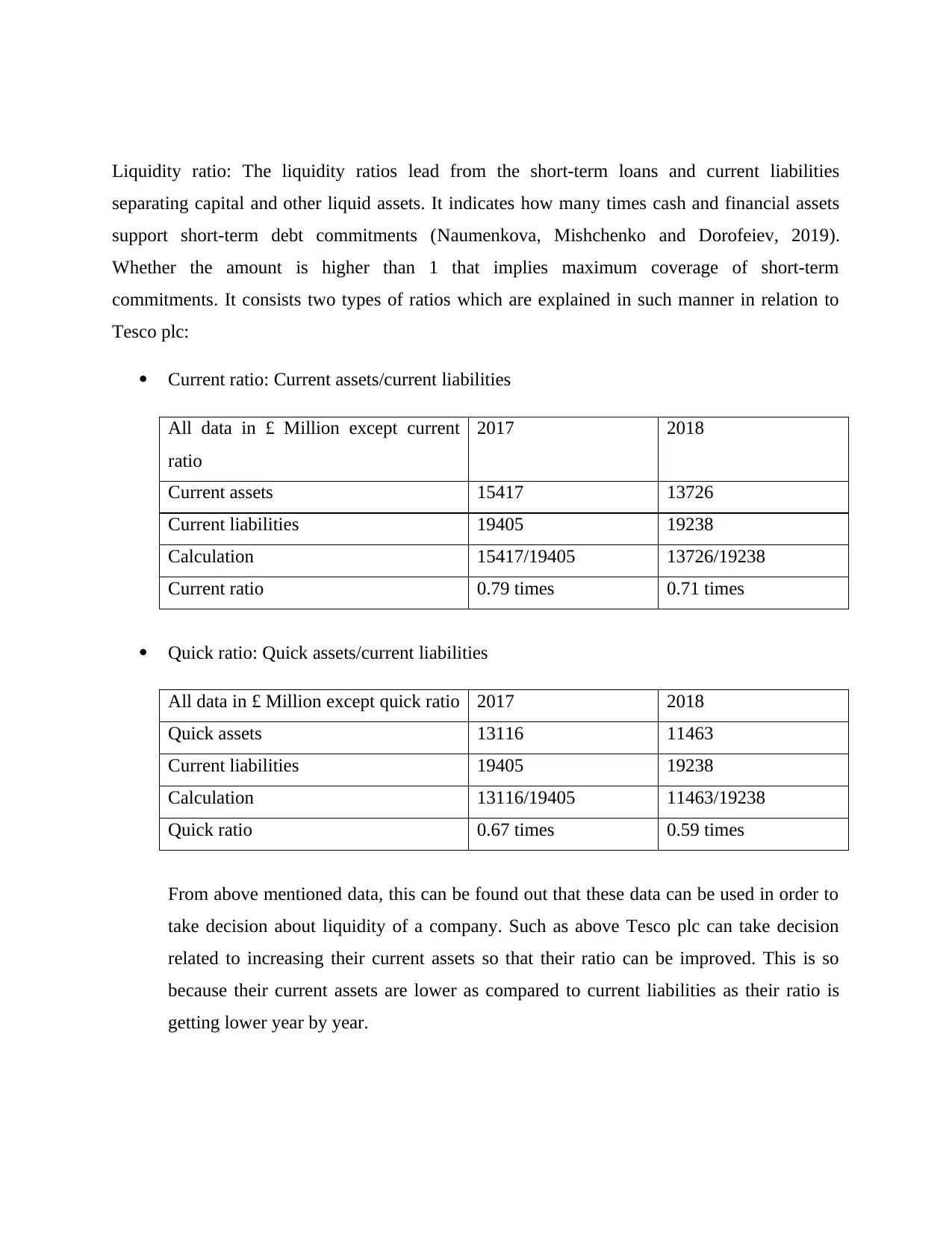
Liquidity ratio: The liquidity ratios lead from the short-term loans and current liabilities
separating capital and other liquid assets. It indicates how many times cash and financial assets
support short-term debt commitments (Naumenkova, Mishchenko and Dorofeiev, 2019).
Whether the amount is higher than 1 that implies maximum coverage of short-term
commitments. It consists two types of ratios which are explained in such manner in relation to
Tesco plc:
Current ratio: Current assets/current liabilities
All data in £ Million except current
ratio
2017 2018
Current assets 15417 13726
Current liabilities 19405 19238
Calculation 15417/19405 13726/19238
Current ratio 0.79 times 0.71 times
Quick ratio: Quick assets/current liabilities
All data in £ Million except quick ratio 2017 2018
Quick assets 13116 11463
Current liabilities 19405 19238
Calculation 13116/19405 11463/19238
Quick ratio 0.67 times 0.59 times
From above mentioned data, this can be found out that these data can be used in order to
take decision about liquidity of a company. Such as above Tesco plc can take decision
related to increasing their current assets so that their ratio can be improved. This is so
because their current assets are lower as compared to current liabilities as their ratio is
getting lower year by year.
separating capital and other liquid assets. It indicates how many times cash and financial assets
support short-term debt commitments (Naumenkova, Mishchenko and Dorofeiev, 2019).
Whether the amount is higher than 1 that implies maximum coverage of short-term
commitments. It consists two types of ratios which are explained in such manner in relation to
Tesco plc:
Current ratio: Current assets/current liabilities
All data in £ Million except current
ratio
2017 2018
Current assets 15417 13726
Current liabilities 19405 19238
Calculation 15417/19405 13726/19238
Current ratio 0.79 times 0.71 times
Quick ratio: Quick assets/current liabilities
All data in £ Million except quick ratio 2017 2018
Quick assets 13116 11463
Current liabilities 19405 19238
Calculation 13116/19405 11463/19238
Quick ratio 0.67 times 0.59 times
From above mentioned data, this can be found out that these data can be used in order to
take decision about liquidity of a company. Such as above Tesco plc can take decision
related to increasing their current assets so that their ratio can be improved. This is so
because their current assets are lower as compared to current liabilities as their ratio is
getting lower year by year.
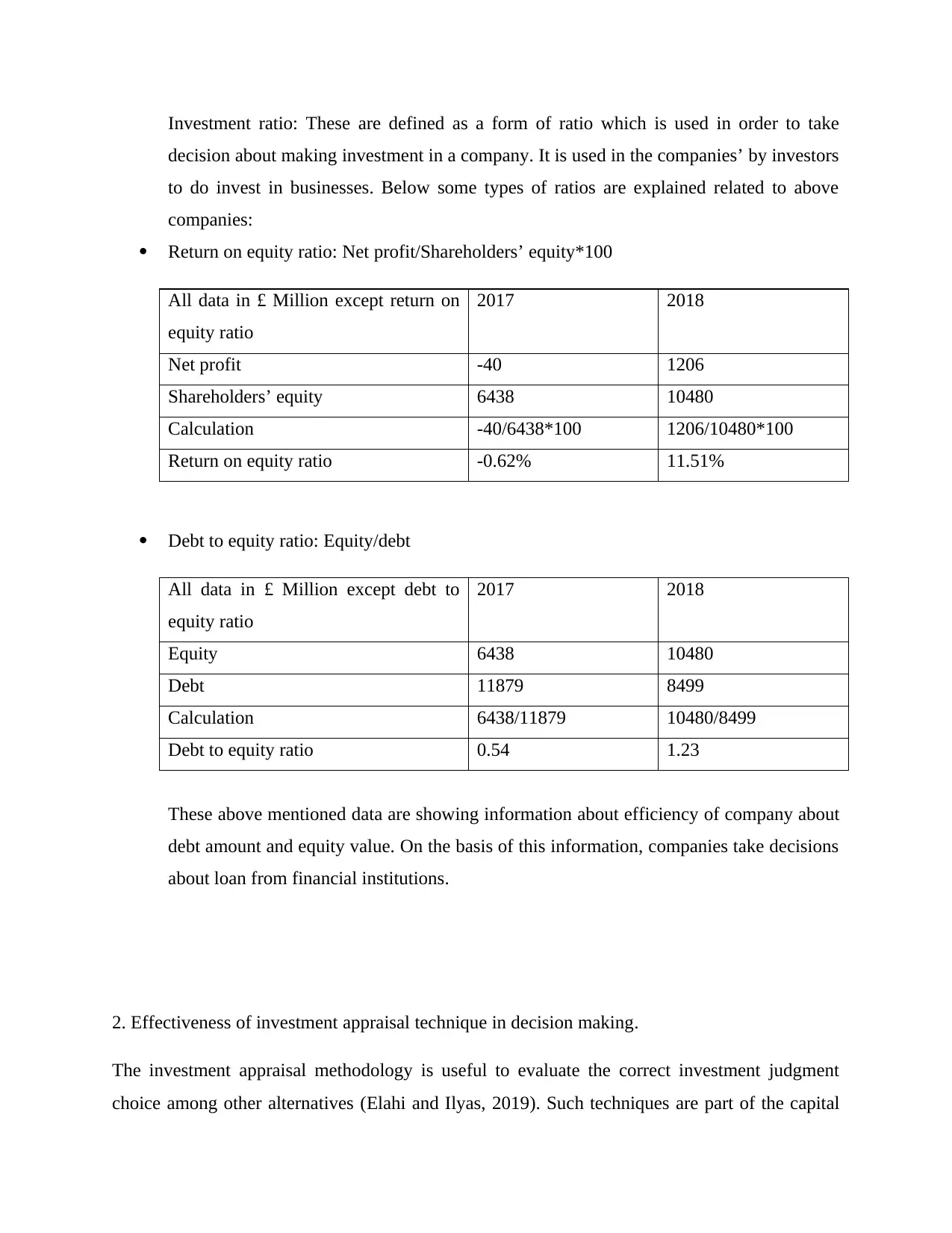
Investment ratio: These are defined as a form of ratio which is used in order to take
decision about making investment in a company. It is used in the companies’ by investors
to do invest in businesses. Below some types of ratios are explained related to above
companies:
Return on equity ratio: Net profit/Shareholders’ equity*100
All data in £ Million except return on
equity ratio
2017 2018
Net profit -40 1206
Shareholders’ equity 6438 10480
Calculation -40/6438*100 1206/10480*100
Return on equity ratio -0.62% 11.51%
Debt to equity ratio: Equity/debt
All data in £ Million except debt to
equity ratio
2017 2018
Equity 6438 10480
Debt 11879 8499
Calculation 6438/11879 10480/8499
Debt to equity ratio 0.54 1.23
These above mentioned data are showing information about efficiency of company about
debt amount and equity value. On the basis of this information, companies take decisions
about loan from financial institutions.
2. Effectiveness of investment appraisal technique in decision making.
The investment appraisal methodology is useful to evaluate the correct investment judgment
choice among other alternatives (Elahi and Ilyas, 2019). Such techniques are part of the capital
decision about making investment in a company. It is used in the companies’ by investors
to do invest in businesses. Below some types of ratios are explained related to above
companies:
Return on equity ratio: Net profit/Shareholders’ equity*100
All data in £ Million except return on
equity ratio
2017 2018
Net profit -40 1206
Shareholders’ equity 6438 10480
Calculation -40/6438*100 1206/10480*100
Return on equity ratio -0.62% 11.51%
Debt to equity ratio: Equity/debt
All data in £ Million except debt to
equity ratio
2017 2018
Equity 6438 10480
Debt 11879 8499
Calculation 6438/11879 10480/8499
Debt to equity ratio 0.54 1.23
These above mentioned data are showing information about efficiency of company about
debt amount and equity value. On the basis of this information, companies take decisions
about loan from financial institutions.
2. Effectiveness of investment appraisal technique in decision making.
The investment appraisal methodology is useful to evaluate the correct investment judgment
choice among other alternatives (Elahi and Ilyas, 2019). Such techniques are part of the capital
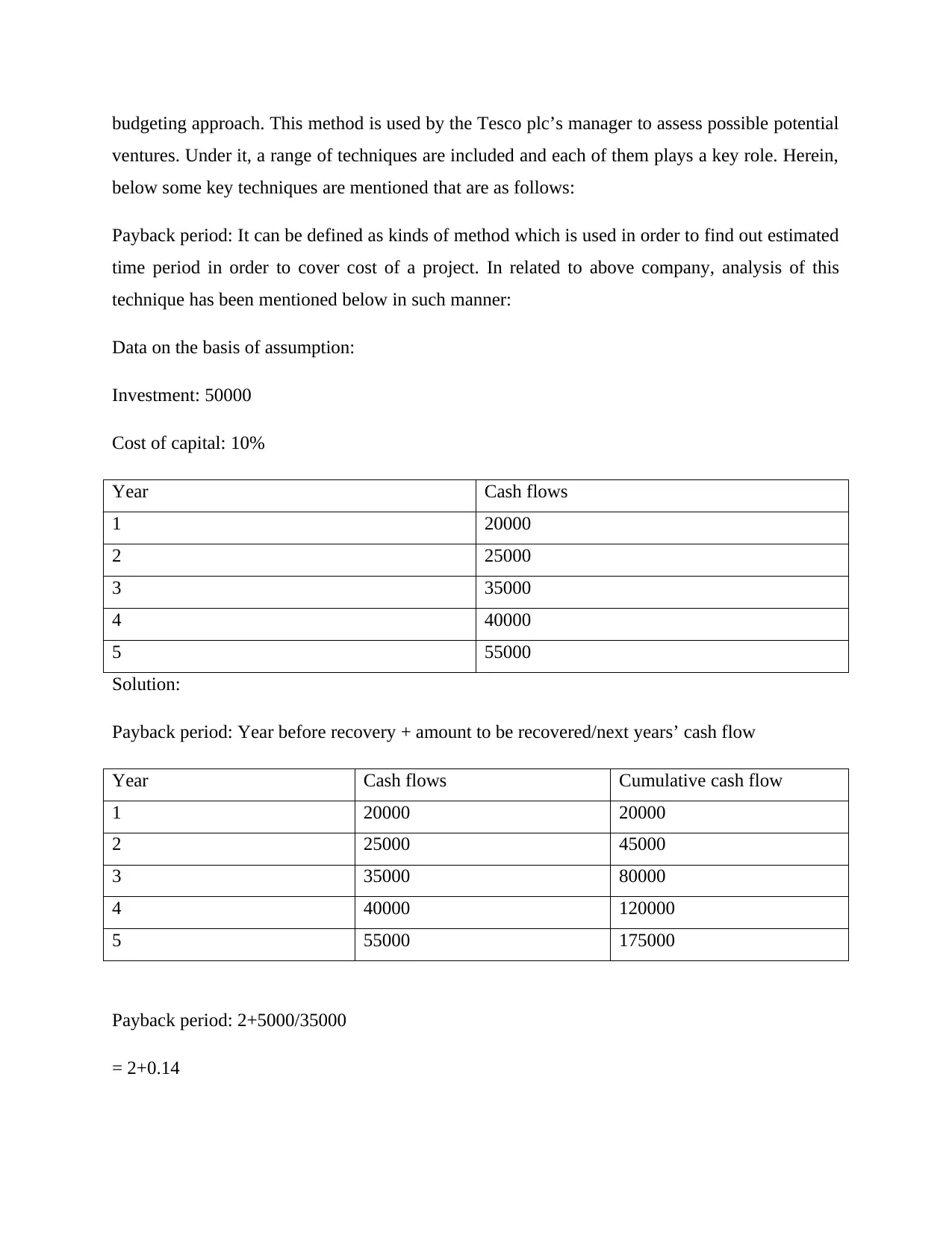
budgeting approach. This method is used by the Tesco plc’s manager to assess possible potential
ventures. Under it, a range of techniques are included and each of them plays a key role. Herein,
below some key techniques are mentioned that are as follows:
Payback period: It can be defined as kinds of method which is used in order to find out estimated
time period in order to cover cost of a project. In related to above company, analysis of this
technique has been mentioned below in such manner:
Data on the basis of assumption:
Investment: 50000
Cost of capital: 10%
Year Cash flows
1 20000
2 25000
3 35000
4 40000
5 55000
Solution:
Payback period: Year before recovery + amount to be recovered/next years’ cash flow
Year Cash flows Cumulative cash flow
1 20000 20000
2 25000 45000
3 35000 80000
4 40000 120000
5 55000 175000
Payback period: 2+5000/35000
= 2+0.14
ventures. Under it, a range of techniques are included and each of them plays a key role. Herein,
below some key techniques are mentioned that are as follows:
Payback period: It can be defined as kinds of method which is used in order to find out estimated
time period in order to cover cost of a project. In related to above company, analysis of this
technique has been mentioned below in such manner:
Data on the basis of assumption:
Investment: 50000
Cost of capital: 10%
Year Cash flows
1 20000
2 25000
3 35000
4 40000
5 55000
Solution:
Payback period: Year before recovery + amount to be recovered/next years’ cash flow
Year Cash flows Cumulative cash flow
1 20000 20000
2 25000 45000
3 35000 80000
4 40000 120000
5 55000 175000
Payback period: 2+5000/35000
= 2+0.14
Secure Best Marks with AI Grader
Need help grading? Try our AI Grader for instant feedback on your assignments.

= 2.14 years
Net present value: It can be defined as a form of method in which a company’s project current
value is determined by help of present value factor. This consists a formula that is applied in
accordance of nature of cash flow. In regards to above mentioned company, this method has
been applied in such manner:
Year Cash
flows
PV
factor
Discounte
d cash
flow
1 20000 0.9091 18182
2 25000 0.8264 20660
3 35000 0.7513 26295.5
4 40000 0.683 27320
5 55000 0.6209 34149.5
126607
Net present value: Discounted cash flow-Investment
= 126607-50000
= 76607 Pounds
Accounting rate of return: ARR is the accounting formula utilized in the budgeting of capital and
is also regarded as the expected rate of return (Srai and Lorentz, 2019). The rate of return does
not utilize the idea of the value of time into consideration. The return produced by ARR is
determined by the net revenue of the planned capital investment. In the context of above
company, this has been applied in such manner:
Net present value: It can be defined as a form of method in which a company’s project current
value is determined by help of present value factor. This consists a formula that is applied in
accordance of nature of cash flow. In regards to above mentioned company, this method has
been applied in such manner:
Year Cash
flows
PV
factor
Discounte
d cash
flow
1 20000 0.9091 18182
2 25000 0.8264 20660
3 35000 0.7513 26295.5
4 40000 0.683 27320
5 55000 0.6209 34149.5
126607
Net present value: Discounted cash flow-Investment
= 126607-50000
= 76607 Pounds
Accounting rate of return: ARR is the accounting formula utilized in the budgeting of capital and
is also regarded as the expected rate of return (Srai and Lorentz, 2019). The rate of return does
not utilize the idea of the value of time into consideration. The return produced by ARR is
determined by the net revenue of the planned capital investment. In the context of above
company, this has been applied in such manner:
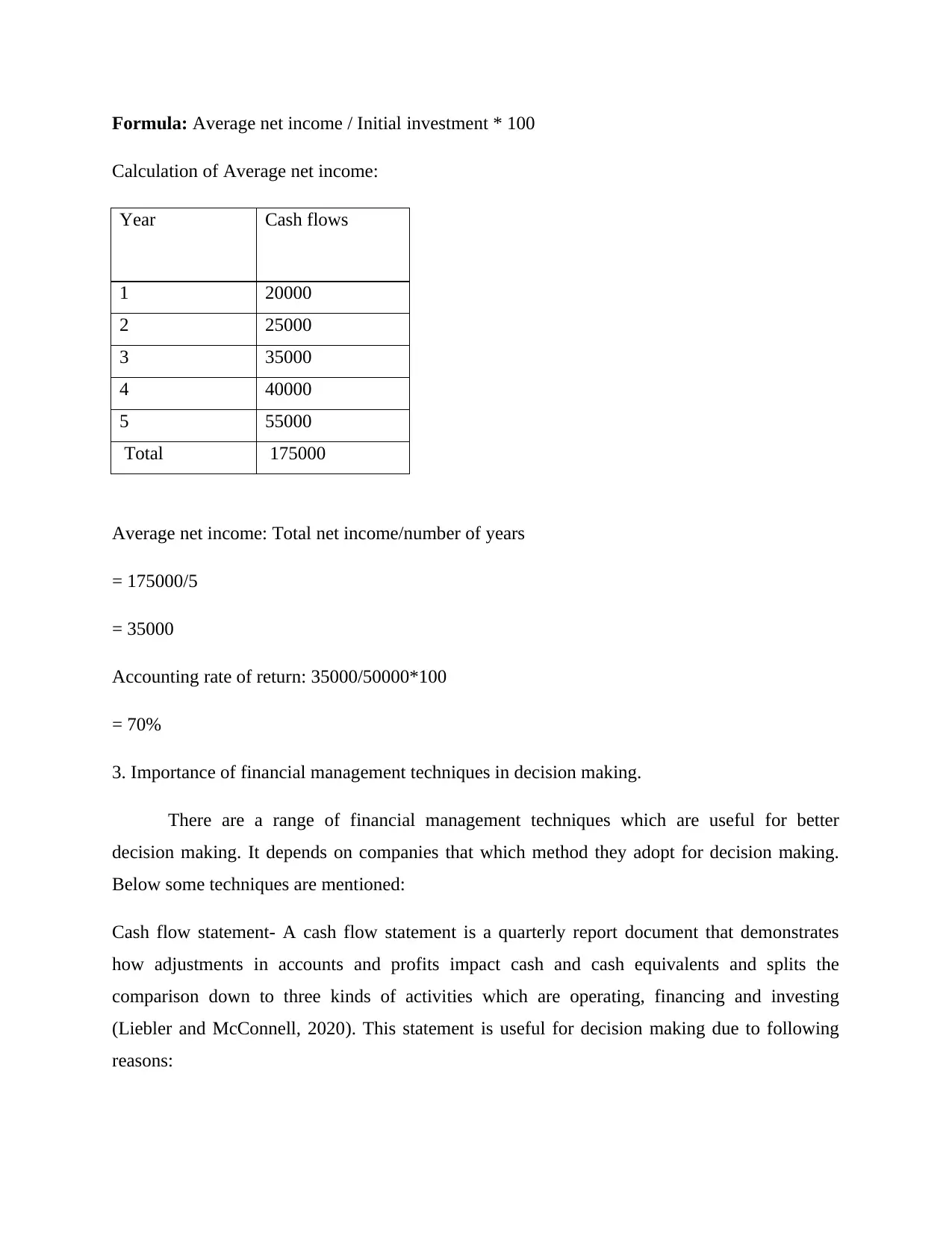
Formula: Average net income / Initial investment * 100
Calculation of Average net income:
Year Cash flows
1 20000
2 25000
3 35000
4 40000
5 55000
Total 175000
Average net income: Total net income/number of years
= 175000/5
= 35000
Accounting rate of return: 35000/50000*100
= 70%
3. Importance of financial management techniques in decision making.
There are a range of financial management techniques which are useful for better
decision making. It depends on companies that which method they adopt for decision making.
Below some techniques are mentioned:
Cash flow statement- A cash flow statement is a quarterly report document that demonstrates
how adjustments in accounts and profits impact cash and cash equivalents and splits the
comparison down to three kinds of activities which are operating, financing and investing
(Liebler and McConnell, 2020). This statement is useful for decision making due to following
reasons:
Calculation of Average net income:
Year Cash flows
1 20000
2 25000
3 35000
4 40000
5 55000
Total 175000
Average net income: Total net income/number of years
= 175000/5
= 35000
Accounting rate of return: 35000/50000*100
= 70%
3. Importance of financial management techniques in decision making.
There are a range of financial management techniques which are useful for better
decision making. It depends on companies that which method they adopt for decision making.
Below some techniques are mentioned:
Cash flow statement- A cash flow statement is a quarterly report document that demonstrates
how adjustments in accounts and profits impact cash and cash equivalents and splits the
comparison down to three kinds of activities which are operating, financing and investing
(Liebler and McConnell, 2020). This statement is useful for decision making due to following
reasons:
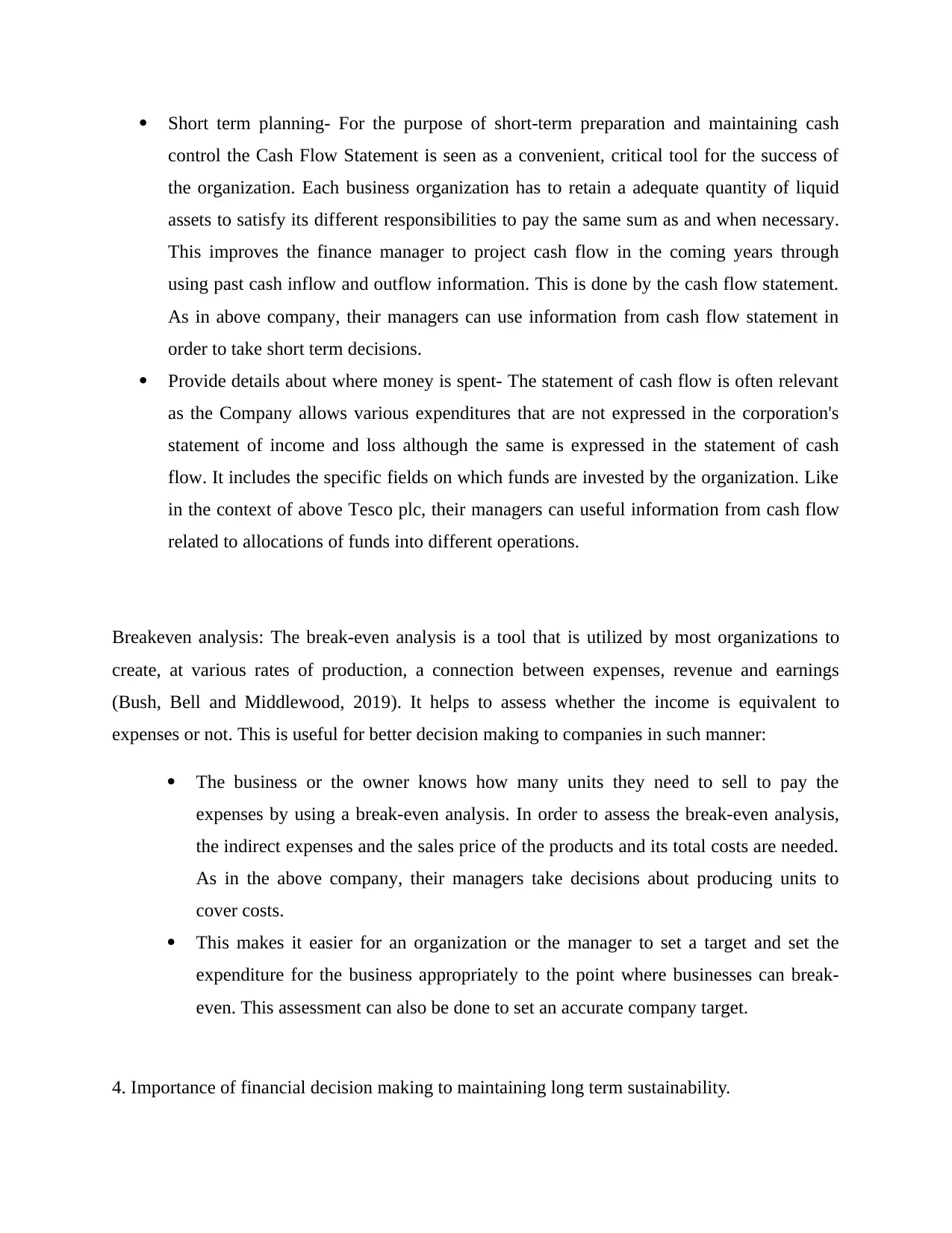
Short term planning- For the purpose of short-term preparation and maintaining cash
control the Cash Flow Statement is seen as a convenient, critical tool for the success of
the organization. Each business organization has to retain a adequate quantity of liquid
assets to satisfy its different responsibilities to pay the same sum as and when necessary.
This improves the finance manager to project cash flow in the coming years through
using past cash inflow and outflow information. This is done by the cash flow statement.
As in above company, their managers can use information from cash flow statement in
order to take short term decisions.
Provide details about where money is spent- The statement of cash flow is often relevant
as the Company allows various expenditures that are not expressed in the corporation's
statement of income and loss although the same is expressed in the statement of cash
flow. It includes the specific fields on which funds are invested by the organization. Like
in the context of above Tesco plc, their managers can useful information from cash flow
related to allocations of funds into different operations.
Breakeven analysis: The break-even analysis is a tool that is utilized by most organizations to
create, at various rates of production, a connection between expenses, revenue and earnings
(Bush, Bell and Middlewood, 2019). It helps to assess whether the income is equivalent to
expenses or not. This is useful for better decision making to companies in such manner:
The business or the owner knows how many units they need to sell to pay the
expenses by using a break-even analysis. In order to assess the break-even analysis,
the indirect expenses and the sales price of the products and its total costs are needed.
As in the above company, their managers take decisions about producing units to
cover costs.
This makes it easier for an organization or the manager to set a target and set the
expenditure for the business appropriately to the point where businesses can break-
even. This assessment can also be done to set an accurate company target.
4. Importance of financial decision making to maintaining long term sustainability.
control the Cash Flow Statement is seen as a convenient, critical tool for the success of
the organization. Each business organization has to retain a adequate quantity of liquid
assets to satisfy its different responsibilities to pay the same sum as and when necessary.
This improves the finance manager to project cash flow in the coming years through
using past cash inflow and outflow information. This is done by the cash flow statement.
As in above company, their managers can use information from cash flow statement in
order to take short term decisions.
Provide details about where money is spent- The statement of cash flow is often relevant
as the Company allows various expenditures that are not expressed in the corporation's
statement of income and loss although the same is expressed in the statement of cash
flow. It includes the specific fields on which funds are invested by the organization. Like
in the context of above Tesco plc, their managers can useful information from cash flow
related to allocations of funds into different operations.
Breakeven analysis: The break-even analysis is a tool that is utilized by most organizations to
create, at various rates of production, a connection between expenses, revenue and earnings
(Bush, Bell and Middlewood, 2019). It helps to assess whether the income is equivalent to
expenses or not. This is useful for better decision making to companies in such manner:
The business or the owner knows how many units they need to sell to pay the
expenses by using a break-even analysis. In order to assess the break-even analysis,
the indirect expenses and the sales price of the products and its total costs are needed.
As in the above company, their managers take decisions about producing units to
cover costs.
This makes it easier for an organization or the manager to set a target and set the
expenditure for the business appropriately to the point where businesses can break-
even. This assessment can also be done to set an accurate company target.
4. Importance of financial decision making to maintaining long term sustainability.
Paraphrase This Document
Need a fresh take? Get an instant paraphrase of this document with our AI Paraphraser
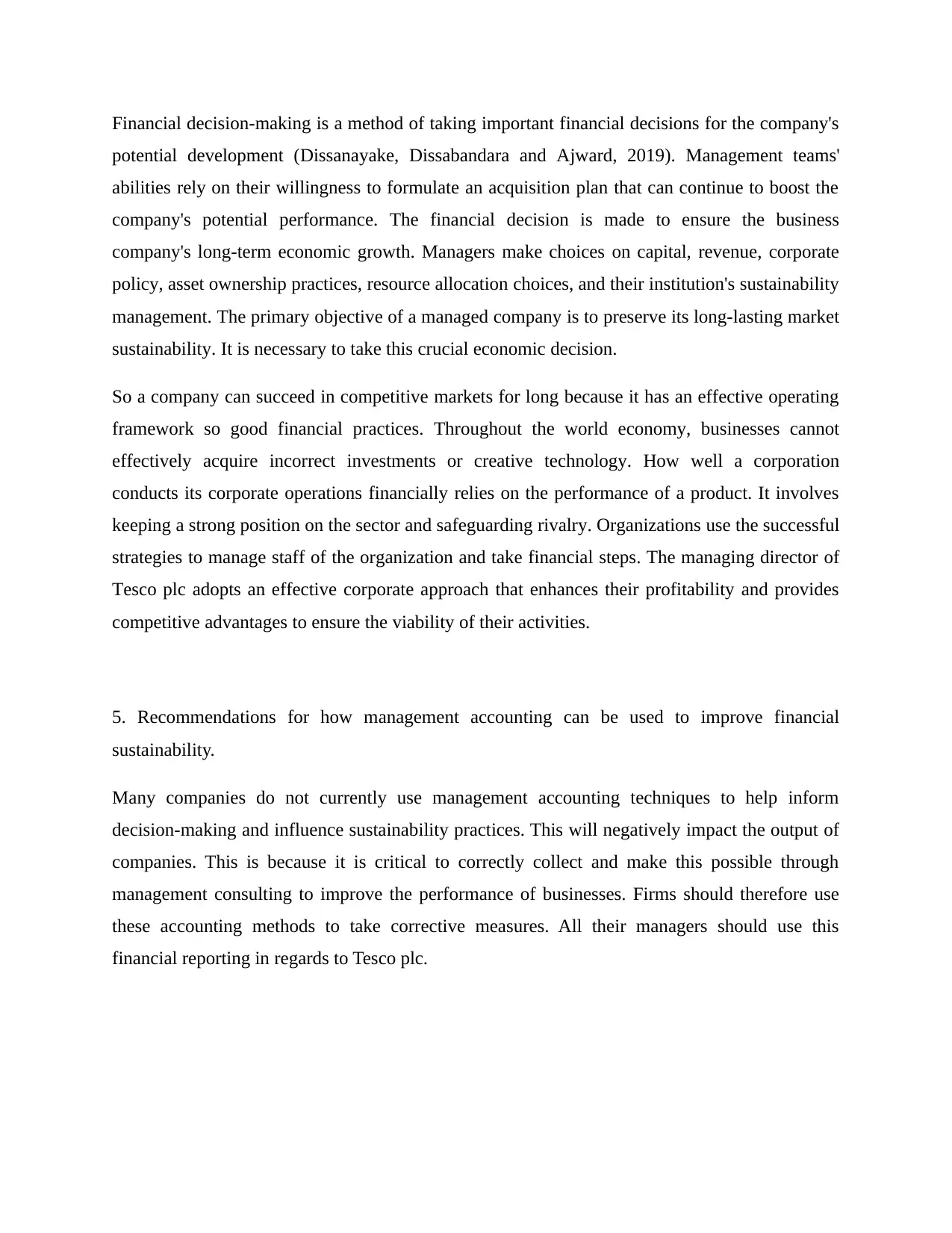
Financial decision-making is a method of taking important financial decisions for the company's
potential development (Dissanayake, Dissabandara and Ajward, 2019). Management teams'
abilities rely on their willingness to formulate an acquisition plan that can continue to boost the
company's potential performance. The financial decision is made to ensure the business
company's long-term economic growth. Managers make choices on capital, revenue, corporate
policy, asset ownership practices, resource allocation choices, and their institution's sustainability
management. The primary objective of a managed company is to preserve its long-lasting market
sustainability. It is necessary to take this crucial economic decision.
So a company can succeed in competitive markets for long because it has an effective operating
framework so good financial practices. Throughout the world economy, businesses cannot
effectively acquire incorrect investments or creative technology. How well a corporation
conducts its corporate operations financially relies on the performance of a product. It involves
keeping a strong position on the sector and safeguarding rivalry. Organizations use the successful
strategies to manage staff of the organization and take financial steps. The managing director of
Tesco plc adopts an effective corporate approach that enhances their profitability and provides
competitive advantages to ensure the viability of their activities.
5. Recommendations for how management accounting can be used to improve financial
sustainability.
Many companies do not currently use management accounting techniques to help inform
decision-making and influence sustainability practices. This will negatively impact the output of
companies. This is because it is critical to correctly collect and make this possible through
management consulting to improve the performance of businesses. Firms should therefore use
these accounting methods to take corrective measures. All their managers should use this
financial reporting in regards to Tesco plc.
potential development (Dissanayake, Dissabandara and Ajward, 2019). Management teams'
abilities rely on their willingness to formulate an acquisition plan that can continue to boost the
company's potential performance. The financial decision is made to ensure the business
company's long-term economic growth. Managers make choices on capital, revenue, corporate
policy, asset ownership practices, resource allocation choices, and their institution's sustainability
management. The primary objective of a managed company is to preserve its long-lasting market
sustainability. It is necessary to take this crucial economic decision.
So a company can succeed in competitive markets for long because it has an effective operating
framework so good financial practices. Throughout the world economy, businesses cannot
effectively acquire incorrect investments or creative technology. How well a corporation
conducts its corporate operations financially relies on the performance of a product. It involves
keeping a strong position on the sector and safeguarding rivalry. Organizations use the successful
strategies to manage staff of the organization and take financial steps. The managing director of
Tesco plc adopts an effective corporate approach that enhances their profitability and provides
competitive advantages to ensure the viability of their activities.
5. Recommendations for how management accounting can be used to improve financial
sustainability.
Many companies do not currently use management accounting techniques to help inform
decision-making and influence sustainability practices. This will negatively impact the output of
companies. This is because it is critical to correctly collect and make this possible through
management consulting to improve the performance of businesses. Firms should therefore use
these accounting methods to take corrective measures. All their managers should use this
financial reporting in regards to Tesco plc.
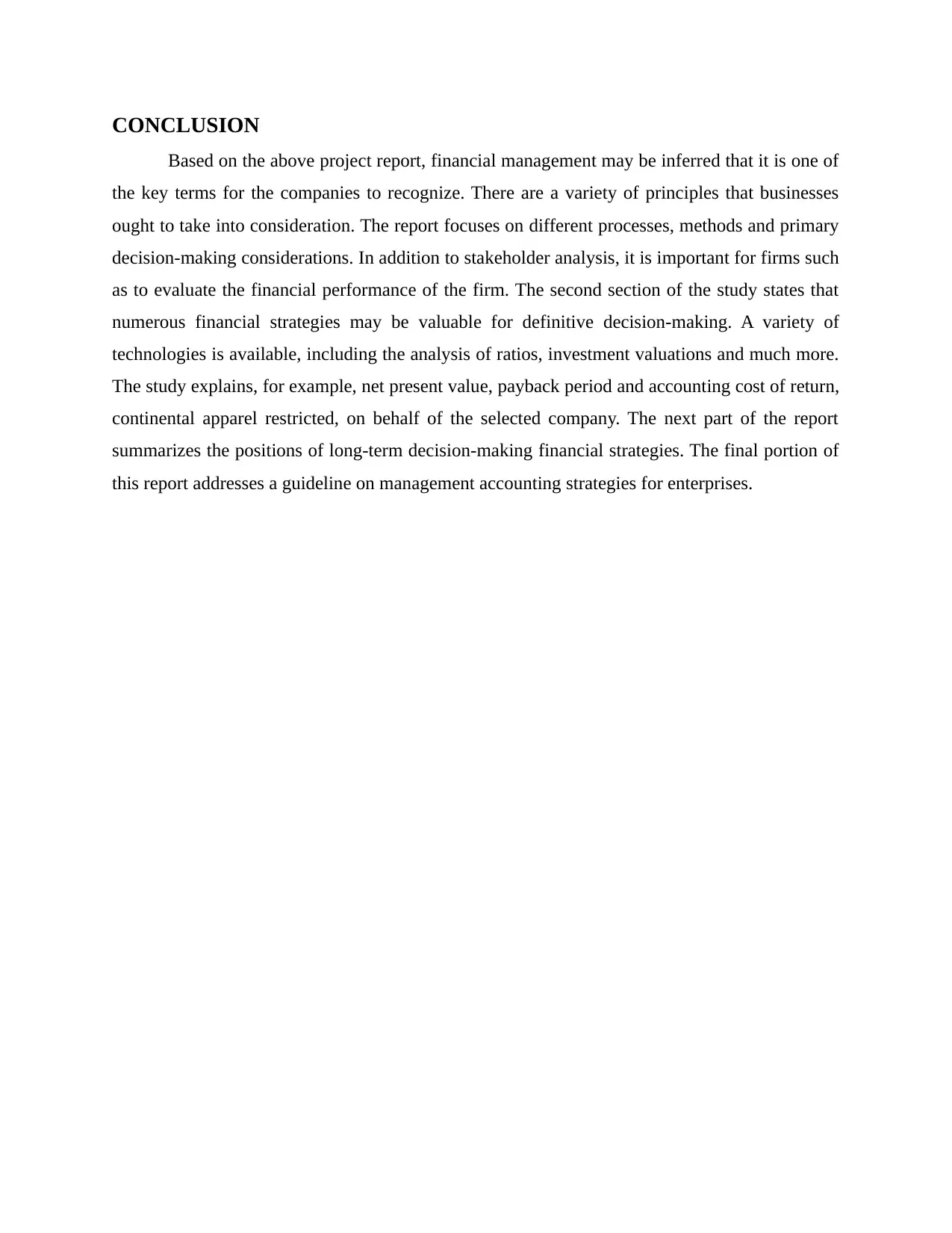
CONCLUSION
Based on the above project report, financial management may be inferred that it is one of
the key terms for the companies to recognize. There are a variety of principles that businesses
ought to take into consideration. The report focuses on different processes, methods and primary
decision-making considerations. In addition to stakeholder analysis, it is important for firms such
as to evaluate the financial performance of the firm. The second section of the study states that
numerous financial strategies may be valuable for definitive decision-making. A variety of
technologies is available, including the analysis of ratios, investment valuations and much more.
The study explains, for example, net present value, payback period and accounting cost of return,
continental apparel restricted, on behalf of the selected company. The next part of the report
summarizes the positions of long-term decision-making financial strategies. The final portion of
this report addresses a guideline on management accounting strategies for enterprises.
Based on the above project report, financial management may be inferred that it is one of
the key terms for the companies to recognize. There are a variety of principles that businesses
ought to take into consideration. The report focuses on different processes, methods and primary
decision-making considerations. In addition to stakeholder analysis, it is important for firms such
as to evaluate the financial performance of the firm. The second section of the study states that
numerous financial strategies may be valuable for definitive decision-making. A variety of
technologies is available, including the analysis of ratios, investment valuations and much more.
The study explains, for example, net present value, payback period and accounting cost of return,
continental apparel restricted, on behalf of the selected company. The next part of the report
summarizes the positions of long-term decision-making financial strategies. The final portion of
this report addresses a guideline on management accounting strategies for enterprises.

REFERENCES
Books and journal:
Shapiro, A.C. and Hanouna, P., 2019. Multinational financial management. John Wiley & Sons.
Chandra, P., 2020. Fundamentals of Financial Management|. McGraw-Hill Education.
Madura, J., 2020. International financial management. Cengage Learning.
Mitchell, G.E. and Calabrese, T.D., 2019. Proverbs of nonprofit financial management. The
American Review of Public Administration, 49(6), pp.649-661.
Apte, P.G. and Kapshe, S., 2020. International Financial Management|. McGraw-Hill
Education.
Valaskova, K., Bartosova, V. and Kubala, P., 2019. Behavioural aspects of the financial
decision-making. Organizacija, 52(1), pp.22-31.
Spearman, K., 2019. Financial management for local government (Vol. 1). Routledge.
Yuniningsih, Y., Pertiwi, T. and Purwanto, E., 2019. Fundamental factor of financial
management in determining company values. Management Science Letters, 9(2), pp.205-
216.
Dermit-Richard, N., Scelles, N. and Morrow, S., 2019. French DNCG management control
versus UEFA Financial Fair Play: a divergent conception of financial regulation
objectives. Soccer & Society, 20(3), pp.408-430.
Rudani, R.B., 2020. Principles of management. McGraw-Hill Education.
Naumenkova, S., Mishchenko, S. and Dorofeiev, D., 2019. Digital financial inclusion: Evidence
from Ukraine. Investment Management and Financial Innovations, 16(3), pp.194-205.
Elahi, F. and Ilyas, M., 2019. Quality management principles and school quality. The TQM
Journal.
Liebler, J.G. and McConnell, C.R., 2020. Management principles for health professionals. Jones
& Bartlett Learning.
Dissanayake, H., Dissabandara, H. and Ajward, R., 2019. Compliance With Disclosure
Principles and Financial Performance: Empirical Evidence From Sri Lankan Listed
Companies. Available at SSRN 3497536.
Bush, T., Bell, L. and Middlewood, D. eds., 2019. Principles of Educational Leadership &
Management. SAGE Publications Limited.
Books and journal:
Shapiro, A.C. and Hanouna, P., 2019. Multinational financial management. John Wiley & Sons.
Chandra, P., 2020. Fundamentals of Financial Management|. McGraw-Hill Education.
Madura, J., 2020. International financial management. Cengage Learning.
Mitchell, G.E. and Calabrese, T.D., 2019. Proverbs of nonprofit financial management. The
American Review of Public Administration, 49(6), pp.649-661.
Apte, P.G. and Kapshe, S., 2020. International Financial Management|. McGraw-Hill
Education.
Valaskova, K., Bartosova, V. and Kubala, P., 2019. Behavioural aspects of the financial
decision-making. Organizacija, 52(1), pp.22-31.
Spearman, K., 2019. Financial management for local government (Vol. 1). Routledge.
Yuniningsih, Y., Pertiwi, T. and Purwanto, E., 2019. Fundamental factor of financial
management in determining company values. Management Science Letters, 9(2), pp.205-
216.
Dermit-Richard, N., Scelles, N. and Morrow, S., 2019. French DNCG management control
versus UEFA Financial Fair Play: a divergent conception of financial regulation
objectives. Soccer & Society, 20(3), pp.408-430.
Rudani, R.B., 2020. Principles of management. McGraw-Hill Education.
Naumenkova, S., Mishchenko, S. and Dorofeiev, D., 2019. Digital financial inclusion: Evidence
from Ukraine. Investment Management and Financial Innovations, 16(3), pp.194-205.
Elahi, F. and Ilyas, M., 2019. Quality management principles and school quality. The TQM
Journal.
Liebler, J.G. and McConnell, C.R., 2020. Management principles for health professionals. Jones
& Bartlett Learning.
Dissanayake, H., Dissabandara, H. and Ajward, R., 2019. Compliance With Disclosure
Principles and Financial Performance: Empirical Evidence From Sri Lankan Listed
Companies. Available at SSRN 3497536.
Bush, T., Bell, L. and Middlewood, D. eds., 2019. Principles of Educational Leadership &
Management. SAGE Publications Limited.
Secure Best Marks with AI Grader
Need help grading? Try our AI Grader for instant feedback on your assignments.

Srai, J.S. and Lorentz, H., 2019. Developing design principles for the digitalisation of purchasing
and supply management. Journal of Purchasing and Supply Management, 25(1), pp.78-
98.
and supply management. Journal of Purchasing and Supply Management, 25(1), pp.78-
98.
1 out of 20
![[object Object]](/_next/static/media/star-bottom.7253800d.svg)




